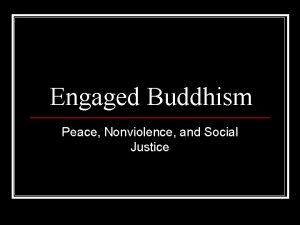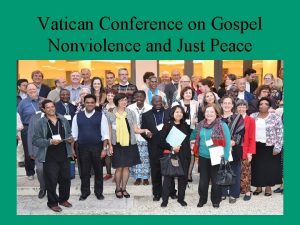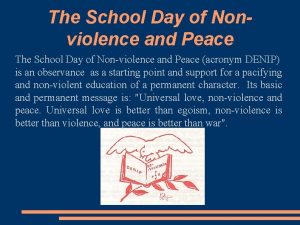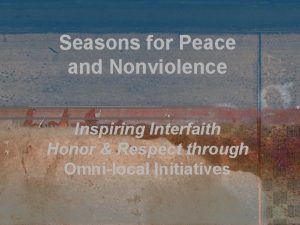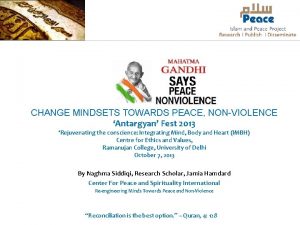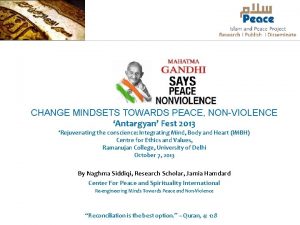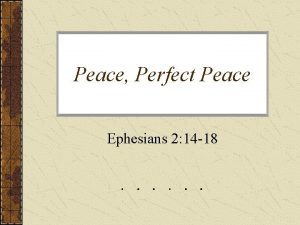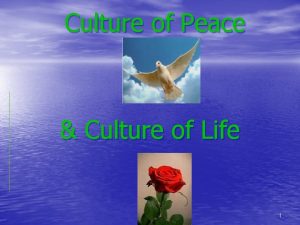A Culture of Peace and NonViolence UNESCOs Programme












- Slides: 12

A Culture of Peace and Non-Violence UNESCO’s Programme of Action Katérina Stenou, Director Intersectoral Platform for a Culture of Peace and Non-Violence 1 st International Congress: « Building Peace in the 21 th century » Barcelona, Spain (23 -25 April 2012)

UNESCO’s Programme of Action for a Culture of Peace and Non-Violence Contents § Introduction § Main goals § Achievable expectations § Strategy: Two main approaches - Main areas of action - Some flagship activities § The way forward

UNESCO’s Programme of Action for a Culture of Peace and Non-Violence Introduction “… When the United Nations General Assembly proclaimed the Decade for the Culture of Peace (2001 -2010), the goals were clear. Member States wanted to tackle the roots of conflict. They wanted to promote the resolution of problems through peaceful means. And they wanted to ensure human rights and participation for all. To do all this, they dedicated the Decade to mainstreaming the values, attitudes and behaviours that form the cornerstone of peace: diversity, tolerance, dialogue (…). As lead UN agency for the Decade and the Year, UNESCO mobilized a wide variety of actors, at all levels, in all regions. Bridges were built that I hope will be reinforced in the years ahead. But the human family continues to face serious challenges and obstacles -- conflicts, violence, bigotry, intolerance and exclusion, in old forms and new. This dark reality compels us to continue the efforts (…)” UN Secretary-General Ban Ki-moon UNESCO’s second High Level Meeting on Peace and Dialogue among Cultures (11 March 2011, New York, USA)

UNESCO’s Programme of Action for a Culture of Peace and Non-Violence Introduction Peace is in UNESCO’s DNA All UNESCO Sectors promote genuine international cooperation and partnerships which value and enhance human potential and capabilities for living together peacefully, free and equal. The Organization seeks to "advancing, through the educational, scientific and cultural relations of the peoples of the world, the objectives of international peace and of the common welfare of mankind" by adapting its vision and action to the local and international contexts. “A peace based exclusively upon the political and economic arrangements of governments would not be a peace which could secure the unanimous, lasting and sincere support of the peoples of the world, and that the peace must therefore be founded, if it is not to fail, upon the intellectual and moral solidarity of mankind“ (UNESCO’s Constitution, over 60 years ago). “Since wars begin in the minds of men, it is in the minds of men that the defences of peace must be constructed” (UNESCO’s Constitution Preamble).

UNESCO’s Programme of Action for a Culture of Peace and Non-Violence Introduction New context At the dawn of the second decade of the twenty-first century, the threats to peace are becoming diversified as the world has to address new challenges. These challenges are frequently political, economic, sometimes environmental and sometimes a mix of all. New process A new conceptual, political and programmatic approach is needed to address the virtuous cycle between cultural diversity and intercultural dialogue to cultivate a lasting peace.

UNESCO’s Programme of Action for a Culture of Peace and Non-Violence Adopted by UNESCO’s 36 th General Conference, November 2011 Main goals • To develop a new political, conceptual and programmatic approach in favour of a strong commitment by States and civil society to nurture “everyday peace” involving women and youth, (i. e. : through ICTs and social media) • To improve the world’s global understanding and deconstruct preconceived ideas by placing emphasis on the future as a humanistic aspiration (i. e. : by establishing guidelines for a global curriculum on shared values) • To promote a global movement in favour of the ideals and practice of a culture of peace and non-violence with emphasis on youth civic engagement and democratic participation (i. e. : by creating “hubs of peace”). A Culture of Peace “consists of values, attitudes and behaviours that reflect and inspire social interaction and sharing based on the principles of freedom, justice and democracy, all human rights, tolerance and solidarity, that reject violence and endeavour to prevent conflicts by tackling their root causes to solve problems through dialogue and negotiation and that guarantee the full exercise of all rights and the means to participate fully in the development process of their society” (UNGA in 1999 A/RES/53/243).

UNESCO’s Programme of Action for a Culture of Peace and Non-Violence Adopted by UNESCO’s 36 th General Conference, November 2011 Achievable expectations • Fondamental principles of peace universally shared to be appropriated by different cultures, thanks to a genuine dialogue and mainstreamed into public policies • Tension between universality and particularism, cultural identities and citizenship in a globalized world analyzed and better understood • Everyday Peace to be conceived as an everyday living experience, not only in periods of conflict, but also in ordinary times. “Peace is more than the absence of war. It is living together with our differences – of sex, race, language, religion or culture – while furthering universal respect for justice and human rights on which such coexistence depends” (Director. General of UNESCO)

UNESCO’s Programme of Action for a Culture of Peace and Non-Violence Strategy: Two main approaches 1. 2. To rethink the dividends of cultural diversity, as benefits of a continuous exchange between cultures To promote the principle of learning to live together, the challenging Art of Unity-in-Diversity conducive to a lasting conviviality Key-notions Cultural Diversity results from a dynamic process. It is the corollary of the intercultural dialogue and gives the creative impetus for changing existing cultural horizons Culture of Peace: A wishful thinking if injustice, inequalities and poverty persist

UNESCO’s Programme of Action for a Culture of Peace and Non-Violence Strategy: Main areas of action • Access to formal and non-formal quality education for all • Research, networking and public debates on the dynamic of the exchanges between cultures • Contribution of the Media and ICTs to change the erroneous perceptions of different cultures and religions • Creativity: conveyor of identity, resource and engine of sustainable development and intercultural dialogue • Learning from the past, namely from the cultural heritage : building shared memories and histories to address intercultural understanding. Rigoberta Menchu Champion Monique Coleman Actor Forest Whitaker

UNESCO’s Programme of Action for a Culture of Peace and Non-Violence Strategy: Some flagship activities • Digital library on major scientific and cultural landmarks, highlighting humankind’s intercultural solidarity (i. e. : the Intercultural Vademecum: a scientific, philosophical, literary and artistic anthology of Muslim/Arab civilization and its contribution to the revival of European Renaissance • E-Notebooks on peace and intercultural dialogue (stories, projects, interviews, quizzes, to be developed by youth, sharing personal initiatives and experiences) • Promotion of high profile events (exhibitions, festivals, contests, public debates, etc. ) to mobilize a large number of actors § Interactive e-portal, where users can find a genuine place of dialogue, conducive to mutual understanding.

UNESCO’s Programme of Action for a Culture of Peace and Non-Violence The way forward: living and thinking peace as a compass of the international agenda beyond 2015 Conclusive remarks towards a sustainable future • Peace and Development = two sides of a same coin • The “everyday peace” nurtured by humanity’s experiences and aspirations, requires a holistic approach of policies, giving the right to a say in one’s own future and particularly to young people who have unimagined possibilities of global conversations • Lasting peace in our more and more plural societies, requires respect for dignity, justice and a decent life in a clean environment; gap reduction between wealth and poverty as well as women’s empowerment; fight against hatred speech, marginalization, xenophobia and conflict • UNESCO’s fields of competences: fields of smart/soft power, transformative tools for human dignity, freedom, equality, mutual trust, shared responsibilities and intercultural solidarity, as main ingredients for democracy and a new humanism.

UNESCO’s Programme of Action for a Culture of Peace and Non-Violence Thank you Katérina Stenou Director, Intersectoral Platform for a Culture of Peace and Non-Violence k. stenou@unesco. org
 Pop culture examples
Pop culture examples Continuous culture and batch culture
Continuous culture and batch culture Indian vs american culture
Indian vs american culture Stab and stroke culture
Stab and stroke culture Folk culture and popular culture venn diagram
Folk culture and popular culture venn diagram What is folk culture
What is folk culture Tsi
Tsi Homework due today
Homework due today Stroke culture method
Stroke culture method Lawn culture method
Lawn culture method Surface culture deep culture and esol
Surface culture deep culture and esol Individual culture traits combine to form culture patterns.
Individual culture traits combine to form culture patterns. Batch culture vs continuous culture
Batch culture vs continuous culture















